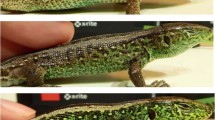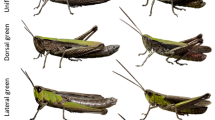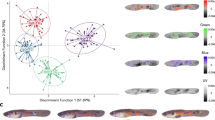Abstract
A NUMBER of population genetics models predict the evolution of male sexual ornaments through female choice1, but their genetic assumptions and predictions have hardly been investigated2,3. A key feature of these models is a positive genetic correlation between male ornaments and female preference for them4. Here I test this prediction at the within-population level with three-spined sticklebacks, Gasterosteus aculeatus, which show conspicuous sexual dichromatisnr. Intense red males are preferred in various situations6–10, but there is great intrapopulational variation in redness both among wild-caught6,10 and among laboratory-bred males11, which is partly environmental6 and may be partly genetic12,13. Also, females show considerable intrapopulational variation in their preference for redder males6,8,9, which is partly environmental8,9. Wild-caught, intense red males and dull males were crossed with a number of females from the same population in a full-sib/half-sib breeding design. Daughters were tested for their preference for more intensely red males, and the sons' coloration was quantified. Both traits showed genetic variation. Also the redness of the sons correlated with the preference for red of their sisters, thus the two traits show positive genetic correlation.
This is a preview of subscription content, access via your institution
Access options
Subscribe to this journal
Receive 51 print issues and online access
$199.00 per year
only $3.90 per issue
Buy this article
- Purchase on Springer Link
- Instant access to full article PDF
Prices may be subject to local taxes which are calculated during checkout
Similar content being viewed by others
References
Maynard Smith, J. Trends Ecol. Evol. 6, 146–151 (1991).
Heisler, L. et al. in Sexual Selection: Testing the Alternatives (eds Bradbury, J. W. & Andersson, M. B.) (Wiley, Chichester, 1987).
Bakker, T. C. M. Neth. J. Zool. 40, 617–642 (1990).
Kirkpatrick, M. & Ryan, M. J. Nature 350, 33–38 (1991).
Darwin, C. The Descent of Man, and Selection in Relation to Sex (Murray, London, 1871).
Milinski, M. & Bakker, T. C. M. Nature 344, 330–333 (1990).
McLennan, D. A. & McPhail, J. D. Can. J. Zool. 68, 482–492 (1990).
Bakker, T. C. M. & Milinski, M. Behav. Ecol. Sociobiol. 29, 205–210 (1991).
Milinski, M. & Bakker, T. C. M. Proc. R. Soc. B250, 229–233 (1992).
Bakker, T. C. M. & Mundwiler, B. Behav. Ecol. (in the press).
Bakker, T. C. M. Behaviour 98, 1–144 (1986).
Hagen, D. W. & Moodie, G. E. E. Evolution 33, 641–648 (1979).
Bakker, T. C. M. in The Evolutionary Biology of the Threespine Stickleback (eds Bell, M. A. & Foster, S. A.) (Oxford Univ. Press. Oxford, in the press).
Laurent, P. J. J. Fish. Res. Bd. Canada 29, 867–875 (1972).
Falconer, D. S. Introduction to Quantitative Genetics 3rd edn (Longman, Harlow, 1989).
Frischknecht, M. Evol. Ecol. (in the press).
Becker, W. A. Manual of Quantitative Genetics 4th edn (Academic Enterprises, Pullman, 1985).
Robertson, A. Biometrics 15, 469–485 (1959).
Lande, M. Proc. natn. Acad. Sci. 78, 3721–3725 (1981).
van Noordwijk, A. J. in Population Biology and Evolution (eds Wöhrman, K. & Loeschcke, V.) (Springer, Heidelberg, 1984).
Kearns, P. W. E., Tomlinson, I. P. M., Veltman, C. J. & O'Donald, P. Heredity 68, 385–389 (1992).
O'Donald, P. & Majerus, M. E. N. Heredity 69, 521–526 (1992).
Ritchie, M. G. Trends Ecol. Evol. 7, 328–329 (1992).
Kirkpatrick, M. Evolution 36, 1–12 (1982).
Seger, J. Evolution 39, 1185–1193 (1985).
Heisler, I. L. Heredity 55, 187–198 (1985).
Kirkpatrick, M., Price, T. & Arnold, S. J. Evolution 44, 180–193 (1990).
Barton, N. H. & Turelli, M. Genetics 127, 229–255 (1991).
Pomiankowski, A., Iwasa, Y. & Nee, S. Evolution 45, 1422–1430 (1991).
Iwasa, Y., Pomiankowski, A. & Nee, S. Evolution 45, 1431–1442 (1991).
Kirkpatrick, M. J. theor. Biol. 119, 263–271 (1986).
Tomlinson, I. P. M. Heredity 60, 283–293 (1988).
Sokal, R. R. & Rohlf, F. J. Biometry 2nd edn (Freeman, New York, 1981).
Endler, J. A. Biol. J. Linn. Soc. 41, 315–352 (1990).
Endler, J. A. Vision Res. 31, 587–608 (1991).
Author information
Authors and Affiliations
Rights and permissions
About this article
Cite this article
Bakker, T. Positive genetic correlation between female preference and preferred male ornament in sticklebacks. Nature 363, 255–257 (1993). https://doi.org/10.1038/363255a0
Received:
Accepted:
Issue Date:
DOI: https://doi.org/10.1038/363255a0
This article is cited by
-
Timing matters: female receptivity and mate choice in the zebrafish (Danio rerio)
Behavioral Ecology and Sociobiology (2022)
-
Genetic segregation for male body coloration and female mate preference in the guppy
BMC Research Notes (2020)
-
Genetic conflict between sexual signalling and juvenile survival in the three-spined stickleback
BMC Evolutionary Biology (2016)
-
Females sample more males at high nesting densities, but ultimately obtain less attractive mates
BMC Evolutionary Biology (2015)
-
Bias in the heritability of preference and its potential impact on the evolution of mate choice
Heredity (2015)
Comments
By submitting a comment you agree to abide by our Terms and Community Guidelines. If you find something abusive or that does not comply with our terms or guidelines please flag it as inappropriate.



